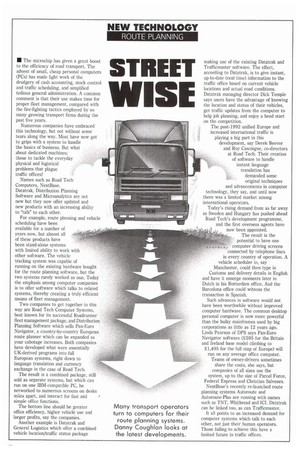STREET
Page 32

If you've noticed an error in this article please click here to report it so we can fix it.
• The microchip has given a great boost to the efficiency of road transport. The advent of small, cheap personal computers (PCs) has made light work of the drudgery of cash accounting, stock control and traffic scheduling, and simplified tedious general administration. A common comment is that their use makes time for proper fleet management, compared with the fire-fighting tactics employed by so many growing transport firms during the past five years.
Numerous companies have embraced this technology, but not without some tears along the way. Most have now got to grips with a system to handle the basics of business. But what about dedicated machines; those to tackle the everyday physical and logistical problems that plague traffic offices?
Names such as Road Tech Computers, NextBase, Datatrak, Distribution Planning Software and Microanalytics are not new but they now offer updated and new products with an increasing ability to `'talk" to each other.
For example, route planning and vehicle scheduling have been available for a number of years now, but almost all of these products have been stand-alone systems with limited ability to work with other software. The vehicle tracking system was capable of running on the existing hardware bought for the route planning software, but the two systems rarely worked as one. Today the emphasis among computer companies is to offer software which talks to related systems, thereby creating a truly efficient means of fleet management.
Two companies to get together in this way are Road Tech Computer Systems, best known for its successful Roadrunner fleet management package, and Distribution Planning Software which sells Pan-Euro Navigator, a country-by-country European route planner which can be expanded as your cabotage increases. Both companies have developed what were essentially UK-derived programs into full European systems, right down to language translation and currency exchange in the case of Road Tech.
The result is a combined package, still sold as separate systems, but which can run on one IBM-compatible PC, be networked to numerous screens on desks miles apart, and interact for fast and simple office functions.
The bottom line should be greater office efficiency, higher vehicle use and larger profits, say the companies.
Another example is Datatrak and General Logistics which offer a combined vehicle location/traffic status package making use of the existing Datatrak and Trafficmaster software. The effect, according to Datatrak, is to give instant, up-to-date (real time) information to the traffic office based on current vehicle locations and actual road conditions. Datatrak managing director Dick Temple says users have the advantage of knowing the location and status of their vehicles, get traffic updates from the computer to help job planning, and enjoy a head start on the competition.
The post-1992 unified Europe and increased international traffic is playing a big part in this development, say Derek Beevor and Roy Cascoigne, co-directors at Road Tech. Their creation of software to handle instant language translation has demanded some original techniques and advancements in computer technology, they say, and until now there was a limited market among international operators.
Today's rising demand from as far away as Sweden and Hungary has pushed ahead Road Tech's development programme, and the first overseas agents have now been appointed.
The result is the potential to have one computer driving screens connected by telephone lines in every country of operation. A vehicle scheduler in, say Manchester, could then type in Customs and delivery details in English and have it emerge moments later in Dutch in his Rotterdam office. And the Barcelona office could witness the transaction in Spanish.
Such advances in software would not have been worthwhile without improved computer hardware. The common desktop personal computer is now more powerful than the bulky mainframes used by big corporations as little as 12 years ago. Linda Pearson of DPS says Pan-Euro Navigator software (£595 for the Britain and Ireland base model climbing to £1,495 for the full map of Europe) will run on any average office computer. Teams of owner-drivers sometimes share the costs, she says, but companies of all sizes use the system, up to the size of Parcel Force, Federal Express and Christian Salvesen. NextBase's recently re-launched route planning systems Autoroute and Autoroute-Plus are running with names such as TNT, Whitbread and ICI. Datatrak can be linked too, as can Trafficmaster.
It all points to an increased demand for computer systems which talk to each other, not just their human operators. Those failing to achieve this have a limited future in traffic offices.




















































































